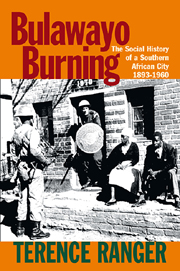Book contents
- Frontmatter
- Contents
- List of Illustrations
- Introduction
- Prelude: Bulawayo, 1893–1930
- 1 The Landscapes of Bulawayo
- 2 The First Fires: December 1929
- 3 City versus State 1930–1946
- 4 Mr Black Bulawayo 1930–1948
- 5 The Feminization of Black Bulawayo 1948–1960
- 6 Black Bulawayo Transformed
- 7 Black Bulawayo Burns 1960
- Postlude: Bulawayo after 1960
- Selected Bibliography
- Index
2 - The First Fires: December 1929
Published online by Cambridge University Press: 05 April 2013
- Frontmatter
- Contents
- List of Illustrations
- Introduction
- Prelude: Bulawayo, 1893–1930
- 1 The Landscapes of Bulawayo
- 2 The First Fires: December 1929
- 3 City versus State 1930–1946
- 4 Mr Black Bulawayo 1930–1948
- 5 The Feminization of Black Bulawayo 1948–1960
- 6 Black Bulawayo Transformed
- 7 Black Bulawayo Burns 1960
- Postlude: Bulawayo after 1960
- Selected Bibliography
- Index
Summary
Introduction
At the end of an eventful 1929, and three and half years before they were deprived of their legal monopoly of the pavements, the whites of Bulawayo celebrated the glories of European urban culture. Oddly, perhaps, for a town which went to so much trouble to proclaim its Britishness and where a dour Lowland Scottish influence was strong, Christmas Eve 1929 became something like a festival. The Chronicle rhapsodized:
Christmas Eve in Bulawayo. Once a year the people of Bulawayo – young and old – forget all worries and cares and remember only that it is Christmas Eve. It has been said that the Britisher is inherently incapable of really feeling the carnival spirit, but judging by the merriment and riotous fun of Christmas Eve this would seem to be scarcely applicable to Rhodesians. Streets were thronging from early in the morning until late at night with pedestrians, motor cars, motor cycles and pedal machines.
People bought paper hats, masks and false noses, entering ‘these shops as ordinary citizens and as often as not coming out so altered by these artificial aids that even their best friends could not have recognised them’:
The noise made by the high-pitched whistles, the rattles and by the babble of voices and the sight of paper caps and streamers made it almost impossible to realise that the modest Bulawayo of December 23 had not been shifted bodily and replaced by a French Carnival in a sub-tropical setting. The crowds at night jostled along the footpaths and into the shops: strings of people linked arms and almost danced their way around the town.
- Type
- Chapter
- Information
- Bulawayo BurningThe Social History of a Southern African City, 1893–1960, pp. 83 - 106Publisher: Boydell & BrewerPrint publication year: 2010



